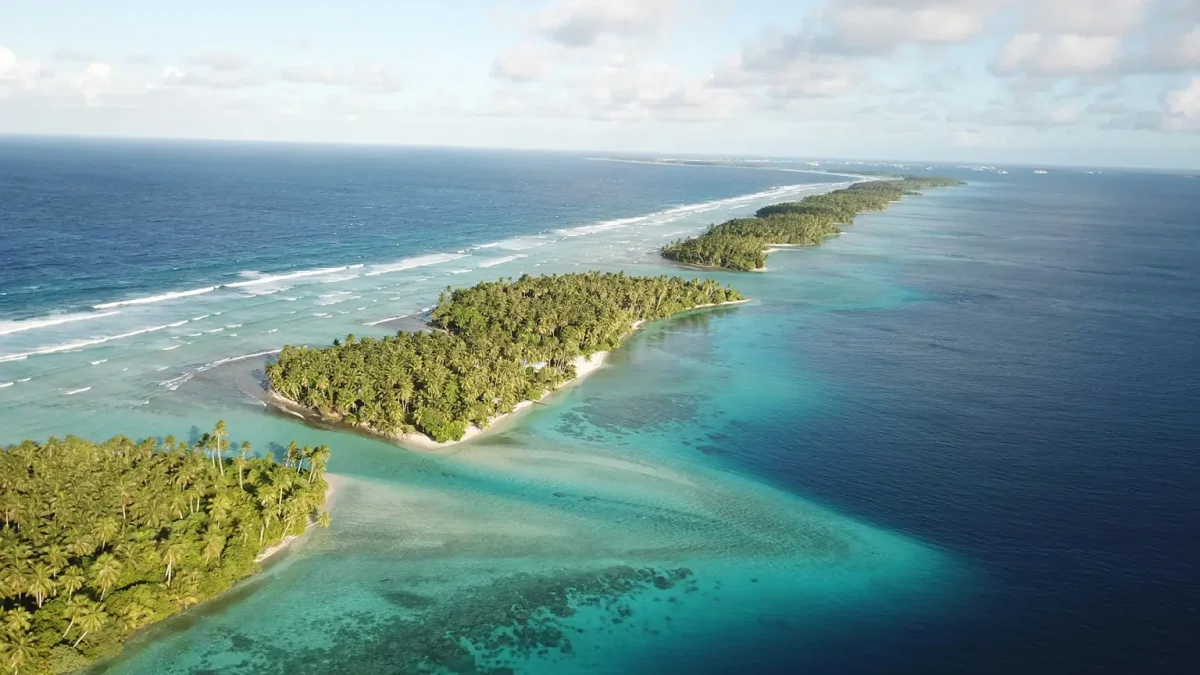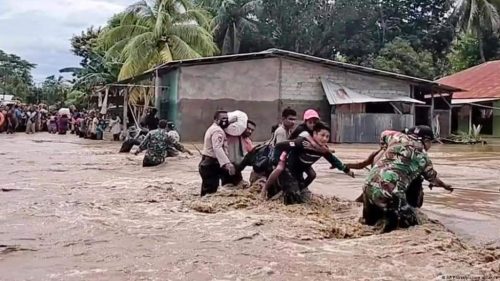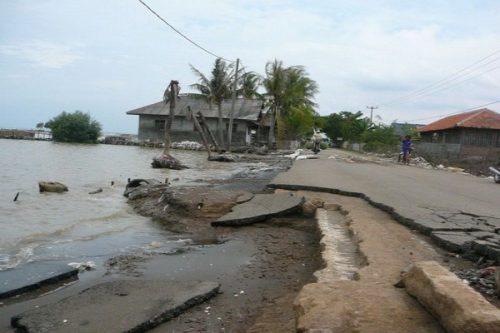The Risk of Disappearing Small Islands: Uncovering the Impacts of Climate Change

Photo Credit : AP
Introduction
Climate change has become an urgent global issue, and one of its often overlooked impacts is the risk of small islands being lost. Small islands, with their stunning natural beauty and abundant biodiversity, have an important role to play in maintaining the balance of the global ecosystem. However, with rising global temperatures and global warming, small islands are faced with inevitable risks. This article will reveal more about the impact of climate change on small islands and why their protection is so crucial. In this case, it will be discussed how sea level rise, coastal erosion, and extreme weather increase the vulnerability of small islands. In addition, this article will also discuss mitigation actions that can be taken to protect small islands from the effects of climate change, as well as the importance of public awareness and active participation in efforts to preserve and sustain the islands' ecosystems. With a deeper understanding of the risks of small islands being lost to climate change, it is hoped that we can take appropriate steps to maintain valuable biodiversity and maintain the sustainability of the global ecosystem as a whole.
Climate Change Impacts
- Sea Level Rise and the Threat of Flooding
Climate change is causing significant sea level rise, and small islands are becoming particularly vulnerable to its impacts. Rising sea levels occur due to the release of greenhouse gases into the atmosphere, leading to global warming and melting of polar ice caps. As a result, sea water increased and began to threaten small islands around the world.
The main impact of sea level rise is the increased threat of flooding for small islands. As sea water rises, islands that have low elevation have a higher risk of flooding. Salt water can seep into the ground and damage freshwater resources on the islands. Plants and vegetation growing on small islands can also be threatened because they are submerged by rising sea water.
The threat of flooding caused by sea level rise also threatens the existence of people living on small islands. They have to face the risk of homelessness, economic loss, and even loss of life. Many small islands that depend on tourism and natural resources are vulnerable to flood damage.
In addition, sea level rise also has an impact on the destruction of valuable coastal ecosystems. The ecosystems of coral reefs, mangroves, and seagrass meadows that protect small islands are threatened by these changes. Losing these ecosystems not only affects biodiversity, but can also reduce natural protection against coastal abrasion and storms.
- Real Case Examples and Statistics related to Flooding on Small Islands
- Global Statistics: According to data from Statista, by the middle of the 21st century, the area flooded annually in small island states due to sea level rise is expected to exceed 15 km², which is an increase of 167 percent compared to 2020 levels. In the worst-case scenario (SSP5-8.5), nearly 45 km² of small island states' land is projected to be flooded by 2150.
- Candikian Island and Gosong Island, West Java: In the Java Sea, Candikian Island and Gosong Island in Indramayu, West Java are also almost submerged, covering an area of only a few square meters with a land height of no more than 2 meters.
- More Frequent and Intense Natural Disasters
Climate change also has a significant impact on the frequency and intensity of natural disasters on small islands. These islands are becoming more vulnerable to disasters such as tropical storms, floods, landslides, and tidal waves that are more frequent and have more severe impacts. Rising sea surface temperatures due to global warming amplify the potential for the formation of stronger and more frequent tropical storms. Small islands are often the main targets of these storms because they are in the path of the storm's trajectory and have direct exposure to strong winds, heavy rain, and high ocean waves. Disasters such as typhoons and tropical cyclones can cause severe damage to infrastructure, settlements, as well as damage coastal ecosystems that play an important role in protecting the islands.
In addition, climate change is also contributing to an increased risk of flooding that is more frequent on small islands. More intense rainfall and longer periods of the rainy season can result in overflowing rivers and puddles that submerge settlements and farmland. Small islands that have flat topography or natural basins are more susceptible to flooding that affects people's daily lives, infrastructure, and economic sustainability.
Higher tides also pose a serious threat to small islands. Rising sea levels cause higher tidal waves and can cause significant coastal abrasion. Small islands with directly exposed coastlines become vulnerable to coastal erosion that can damage coastal ecosystems and threaten infrastructure and community settlements.
Case studies of the impact of cyclones, tropical storms and tidal waves on small islands illustrate how serious the threat of these natural disasters is. For example, when Cyclone Pam hit the Pacific Islands in 2022, small islands like Vanuatu and the Solomon Islands suffered severe damage to their infrastructure, settlements and natural resources due to strong winds and flooding caused by heavy rains. Hurricane Seroja (2018) hit the Maluku and North Maluku regions, causing strong winds, heavy rains, and floods that resulted in damage to infrastructure, settlements, and caused casualties and economic losses.

Photo Credit : TLM Foundation
- Damage to Small Island Ecosystems
Damage to the ecosystem of small islands can be seen, among others, the bleaching of coral reefs on Gili Trawangan Island in Indonesia. Coral reef bleaching caused by rising sea surface temperatures has occurred. The once beautiful and colorful coral reefs are now experiencing significant bleaching, with many areas dying out and losing the marine life that depended on them. This has an impact on tourism businesses and the livelihoods of local fishermen who depend on healthy marine life.
In addition, the destruction of mangrove forests in the Riau Islands, Indonesia, caused by rising temperatures and higher sea water levels. Mangroves that once protected the coast from erosion and tidal waves are now suffering significant damage. As a result, coastal villages in the archipelago have become more vulnerable to catastrophic flooding and the threat of coastal abrasion. In addition, mangrove forest destruction also threatens the lives of unique animals such as mangrove birds and mangrove crabs that depend on these ecosystems.

Photo Credit : M Ali Khumaini/Antara
Mitigation and Adaptation Efforts
- Increased renewable energy : Many small islands have turned to renewable energy sources as a cleaner and more sustainable alternative. For example, in the Maldives Islands, programs have been launched to install solar panels and wind turbines to meet the islands' energy needs. This step helps reduce the use of fossil fuels and greenhouse gas emissions.
- Water and natural resource management : Small islands often face challenges in terms of clean water supply and management of limited natural resources. Many islands are developing rainwater collection systems, efficient water use, and sustainable waste management. For example, on the island of Barbados, rainwater collection and storage systems have been widely implemented to meet the water needs of residents.
- Development of marine parks and conservation areas : Several small islands have established marine parks and conservation areas to protect coral reef ecosystems and local biodiversity. For example, in the Seychelles Islands, Aldabra Marine National Park was established to protect important coral reefs and habitats for endangered species such as green turtles and seabirds.
- Local community empowerment : Small islands also prioritize the empowerment of local communities in mitigation and adaptation efforts. They involve locals in decision-making, training, and education on the importance of sustainability and environmental preservation. In this regard, the island of Tuvalu has adopted education and training programs on water management, renewable energy, and sustainable agriculture.
- Mangrove planting : Mangroves have an important role in maintaining the sustainability of coastal ecosystems. Many small islands in Indonesia have carried out mangrove planting programs as mitigation efforts. For example, on Karimunjawa Island, Central Java, a mangrove rehabilitation and planting program involving local communities was carried out. It helps reduce coastal erosion, store carbon, and maintain biodiversity.
- Waste management : Small islands in Indonesia are also increasing waste management efforts to reduce their negative impact on the environment. Some islands, such as Bali Island and Lombok Island, have implemented community-based waste management programs, including reduction, recycling, and more efficient waste management. This measure helps keep small islands clean and prevents environmental pollution.
- Development of eco-friendly villages : Several small islands in Indonesia have adopted the concept of eco-friendly villages as an effort to adapt to climate change. Villages such as Sawai Village on Seram Island, Maluku, have implemented sustainable practices, such as the use of renewable energy, efficient water management, organic farming, and sustainable management of natural resources.
Conclusion
Small islands around the world, including Indonesia, have taken important initiatives in mitigating and adapting to climate change. These initiatives involve various measures, such as the development of renewable energy, sustainable management of water and natural resources, the establishment of marine parks and conservation areas, and the empowerment of local communities.
Mangrove planting efforts, waste management, the establishment of research and conservation centers, and the implementation of environmentally friendly villages show the commitment of small islands in protecting their ecosystems and biodiversity. The initiative also contributes to the reduction of greenhouse gas emissions, the preservation of natural resources, and the improvement of the resilience of local communities to climate change.
Although many positive steps have been taken, challenges still faced include adequate financing, wider public awareness, and cooperation between relevant parties. Strong international and national support, inter-island collaboration, and efforts to meet the needs of local communities are key to improving the effectiveness of mitigation and adaptation efforts in small islands.
In the face of ever-increasing climate change, it is important for small islands in Indonesia and around the world to continue to innovate, adapt, and maintain the sustainability of ecosystems and the well-being of local communities. Only with shared commitment and concrete action can small islands set an example in protecting the environment and responding to climate change in a sustainable manner.

